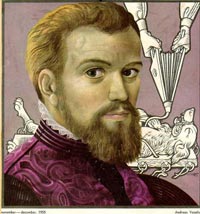
| Born: Dec 31, 1514 in Brussels, Habsburg Netherlands |
| Died: Oct 15, 1564 (at age 49) in Zakynthos |
| Nationality: Brabantian |
| Famous For: De humani corporis fabrica or “the structure of the human body” |
Andreas Vesalius was a Flemish physician who was born in Belgium, Brussels, (which was then part of Holy Roman Empire at the time) on December 31, 1514. The people in his household were pharmacists and physicians. His grandfather, for instance, was a court apothecary. Both Vesalius’s father and grandfather served the Roman emperor, Charles V.
Studies and Schooling
Vesalius studied medicine in Paris but was forced to discontinue his studies before completing his degree when the Roman Empire declared war on France. He then joined a university in Louvain where he continued with his medical degree and later moved to Padua in 1537 to study for his doctorate. After the completion of his studies, Vesalius was offered the chair of surgery and human anatomy.
Vesalius and Human Dissection
Andreas Vesalius is widely referred to as the founding father of the modern anatomy. Roman and Greek laws during his day had forbidden the dissection of the human body. However, Vesalius wanted to learn more about the human anatomy and he felt the best way to do so was to dissect human corpses.
Despite the strict rules by the Roman Empire (Catholic Church) and Greek on the practice of human dissection, Vesalius managed to convince a Paduan judge to allow him to dissect a human corpse. He accomplished this through a pamphlet he wrote about blood-letting, a famous treatment for a variety of illnesses and hence the importance of understanding the human body. The judge allowed him to make repeated and comparative dissection of humans, which were restricted to bodies of executed criminals.
This led to more astonishing discoveries by this anatomist. For instance, Vesalius was able to demonstrate that women and men have an equal number of ribs, contrary to the biblical creation story about Adam and Eve. Also, he differed with Galen’s analogy that humans and apes do not share the same anatomy.
Vesalius’ De Humani Corporis Fabrica
In 1543, Vesalius wrote and published his authoritative book, De Humani Corporis Fabrica (The Structure of the Human Body) based on his extensive work. This book contained about 200 anatomical illustrations. His work is actually considered to be the earliest accurate presentation of human body. In fact, the book contained the most accurate and comprehensive anatomical text and illustrations that have been used from then and are still used today.
Vesalius’s book discredited several of Galen’s doctrines about human anatomy, including the belief that the blood can flow in between the heart’s ventricles and that the human jawbone is composed of more bones. Vesalius’ visible representation of human muscles was also determined to be extremely accurate.
Generally, the book laid a solid foundation for the understanding of the vast human anatomy and it is a basis for any medical practice today. Overall, Andreas Vesalius’ greatest achievement was that of reintroducing anatomy and its importance to the public.
Later Life and His Death
While maintaining the tradition of imperial service, Andreas was nominated as a court doctor to Charles V and his family. Unfortunately, he made the majority of conservative physicians his worst enemies. In 1564, he was accused of murder and atheism, but King Philip II reduced his sentence to a pilgrims’ journey to the Holy Land. On October 15, 1564, Vesalius left on his pilgrimage, but he died on his way back home.